This virtual tour will let you explore some history and historic structures around MCB Camp Lejeune that have restricted or limited access.
Historical Highlights
Women Marines Area

Women first served in the Marine Corps during World War I, taking over clerical jobs to “free a Marine to fight,” and this phenomenon was repeated in World War II for the same purpose. In November 1942 a much-needed increase in manpower resulted in the establishment of the Marine Corps Women’s Reserves (MCWR or WR), whose official birthday was February 13, 1943. When enrollment opened in February 1943, women (all of whom were white, as the WR did not accept black enrollments during the war) joined in sizeable numbers, and the Women’s Reserves easily met its quotas ahead of schedule. Rates of enlistment and the Marine's general acceptance of the Women's Reserves made the new program a success, but the WR was never considered anything but a “wartime expedient” and there was never any question that women Marines would be assigned only to non-combat support jobs.
Initially, the women, both officers and enlisted, received training with the Navy’s Women Accepted for Volunteer Emergency Service (WAVES) at Smith College in Northampton, Massachusetts, and Hunter College in New York City, but by summer 1943 the New River base had been designed as the principal training center for the women Marines. At the beginning of 1943 the WR were quartered in Regimental Area 1, the location of the barracks, classrooms, and administrative offices of the MCWR schools. In March 1943 Camp Lejeune’s own WR Battalion (women post troops) was quartered in a separate Women’s Reserve Area, which was placed adjacent to the Post Troops Area since it would involve the least amount of new site development. While the architectural style and layout of the permanent structures resembled those already erected at the base, special features, such as laundry rooms, ironing boards, extra outlets “for electric irons,” and comfortably equipped lounge rooms, were also provided for the women. Today the street names are the only remaining clues as to the area’s original function.
The advance echelon of 10 female officers arrived at Camp Lejeune in April 1943, followed by 145 enlisted personnel on May 1, 1943. Little more than a month later, the Marine Corps Women’s Reserve Schools were organized. The first women officer candidates were commissioned at Camp Lejeune in August 1943. Approximately 23,000 women joined the Corps during World War II, virtually all of whom were trained at Camp Lejeune. In 1948 the U.S. Congress passed the “Women’s Armed Service Integration Act,” making women a permanent part of the Marine Corps and allowing them regular status. Henceforth they were no longer Women’s Reserves (WR), they were Women Marines (WM).
Montford Point – Camp Johnson

The first African American to wear the Marine uniform, and all African American Marines who served in World War II, received their training on Camp Lejeune’s Montford Point. The segregation policies of the Navy Department during these years required that African American Marines live and train separately from their white counterparts. The Montford Point complex consisted of three “camps.” Recruits were assigned to Camp 1 where they were billeted in composition-board “huts” like those at Tent Camp (Camp Geiger). After basic training, new African American Marines assigned to the Messman Branch or a depot or Ammunition Company was billeted in the concrete block and brick buildings of Camp 2. Camp 3 represented an expansion and upgrading of Camp 1, with more concrete block barracks to house troops instead of the Homosote huts. Recreational facilities, a post exchange, and a chapel were also provided at Camp 1. Units organized at Montford Point during the war included the 51st and 52nd Composite Base Defense Battalions and the 51stdepot companies and 12 ammunition companies. Most of the depot and ammunition companies were posted forward to support combat units in the Pacific.
The Montford Point complex received its present name in 1974, honoring Sgt. Maj. Johnson.

Historic Buildings and Areas
Montford Point Cemetery / North Carolina Veteran’s Cemetery

Montford Point Cemetery was created in the early 1940s for the remains of white persons buried in the numerous community and family cemeteries dotting the land acquired for Camp Lejeune in 1941-42. Among the graves are those of 32 Confederate Civil War Veterans, and Col. Henry Rhodes who commanded the contingent of Onslow County patriots who defeated the British in the Revolutionary War Battle of Moore's Creek. Several markers memorialize members of the Marine family, a surname that predated the coming of the Corps to Onslow County by many years. Many burials here are of persons unknown. Among those interred in the adjacent North Carolina Veterans’ Cemetery is Sgt. Maj. Edgar R. Huff, who was, along with his brother-in-law, Sgt. Maj. Gilbert “Hashmark” Johnson, one of the first African American Marines.
Verona Loop Cemetery

The 85,000 acres of land initially acquired by the government for Camp Lejeune in 1941-42 had been occupied by white and African American communities and farms since the Colonial era. The plantation houses, cabins, farm buildings, stores, and other buildings were removed. Over some 230 years, many residents had been buried in cemeteries large and small. The government compiled extensive records on all the cemeteries that could be identified, and moved most of the remains to new ground on the periphery of the Marine Corps Base. The plot near Verona contains the remains of African Americans, including headstones dating to the early 1800s. Several tombstones are marked with the simple epitaph of a name and a title “slave.” The government placed many others, simple granite faces set flat in the ground, to mark the remains of persons whose names were and are unknown.
The Verona Loop Cemetery was added to the Jacksonville-Onslow African-American Heritage Trail in 2011. Visit this and other African American sites across Onslow County here.
Building 19 Base Theater
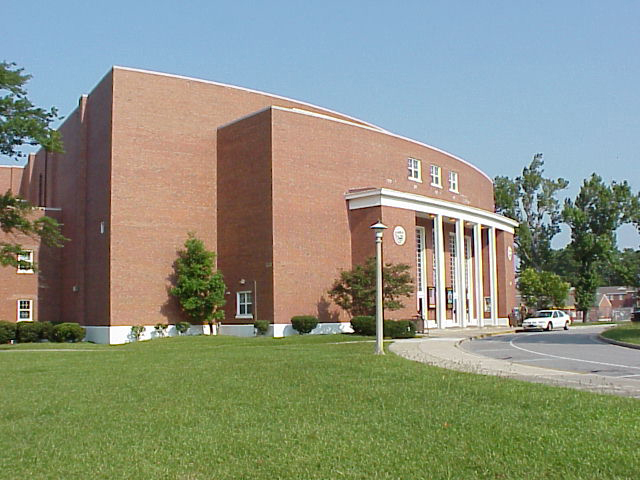
The cast-stone medallions of Tragedy and Comedy adorning both sides of the main entrance portico of Building 19 help to identify it as a theater. The exterior of the theater has not been modified since its original construction in 1942. The theater’s interior lobby still contains elements of its original fabric. Terrazo covers the lobby’s floor, and paneled wainscoting ornaments portions of the wall, while turned wood banisters form the stair’s handrails.
Building H1 / Julian C. Smith Hall
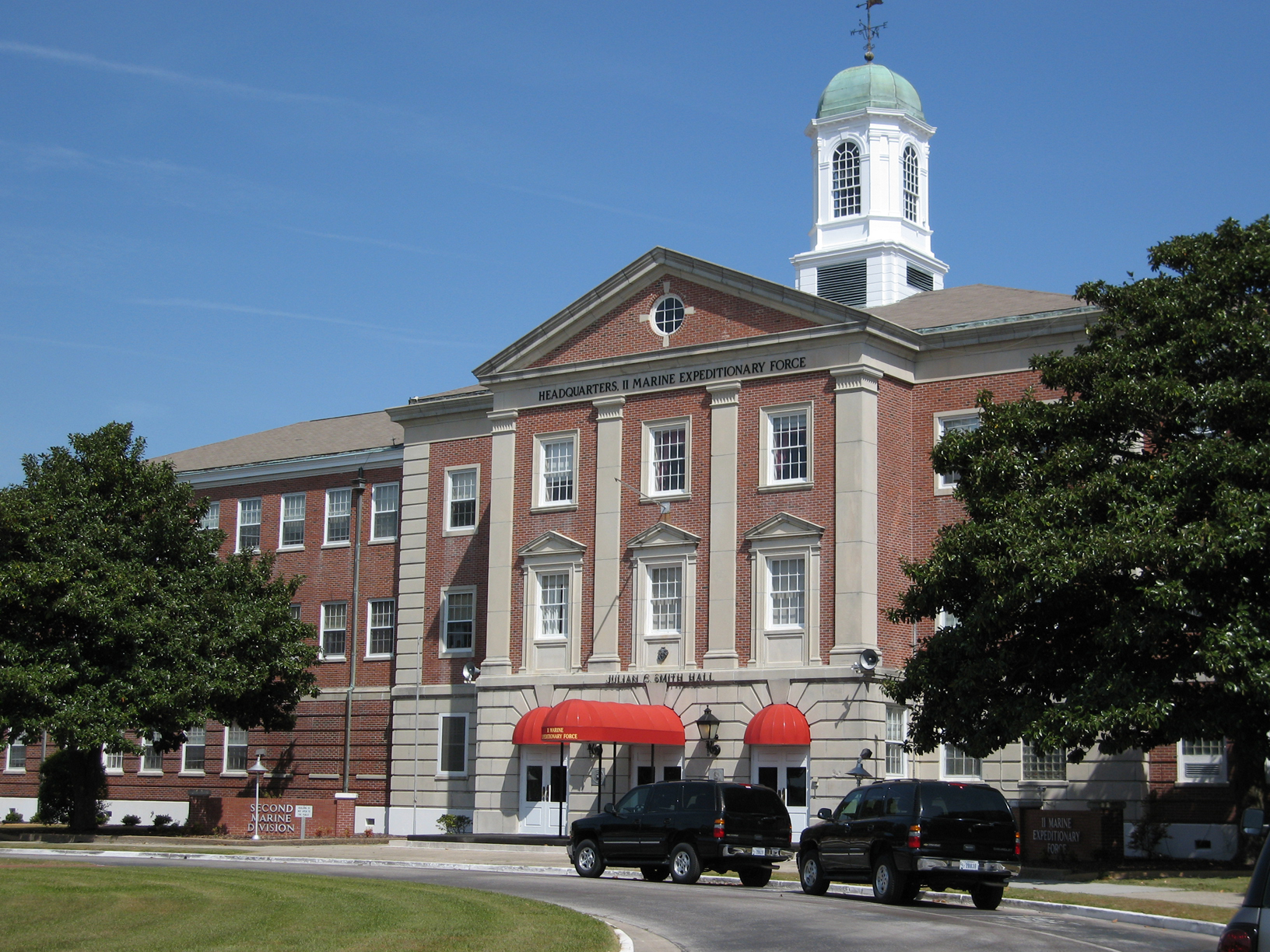
Building H1 was built in 1942-43 as U.S. Naval Hospital, New River, and served as the main hospital for all the Marine Corps Base Camp Lejeune until the Naval Regional Medical Center was opened in 1980. As a hospital, H1 was set at the tip of Hadnot Point, away from the rest of the main station, to prevent the spread of contagious diseases and to buffer the patients from noise. Like other naval hospitals of the time, it was built with two-story wings attached to a three-story central administration section. The medical wards were located in the long rectangular blocks set perpendicular to the main building and were constructed as needed over the course of World War II. Other nearby buildings housed medical corpsmen, nurses, and physicians. With the opening of the Naval Regional Medical Center, Building H1 has found a new use as Headquarters for II Marine Expeditionary Force, one of three Marine Expeditionary Forces in the Marine Corps, and for II MEF’s ground combat element, the 2d Marine Division.
Building H1 is now more commonly known as Julian C. Smith Hall. Lt. Gen. Smith (1885-1975) following Brig. Gen. Allen H. Turnage as Commanding General of the Training Center, Camp Lejeune, which was the primary activity at Camp Lejeune during World War II. Smith had been the senior member of the board that selected Onslow County as the site of this base in 1941. He subsequently served as commanding general of 2d Marine Division at Tarawa.
W.P.T. Hill Field Parade Grounds

W.P.T. Hill Field provides an expansive lawn in the heart of the main station for ceremonies, receptions, parades, and other formal assemblies. The parade ground is named after Lt. Col. W.P.T. Hill who served as the senior Marine officer and Liaison Officer to Headquarters, U.S. Marine Corps during the initial construction of the base. It also hosts community gatherings, open-air concerts, including those by Camp Lejeune’s 2d Marine Division Band, and athletic activities. The field frequently serves as a helicopter-landing zone for both administrative and tactical helicopter lifts.
Building 1 / Base Headquarters
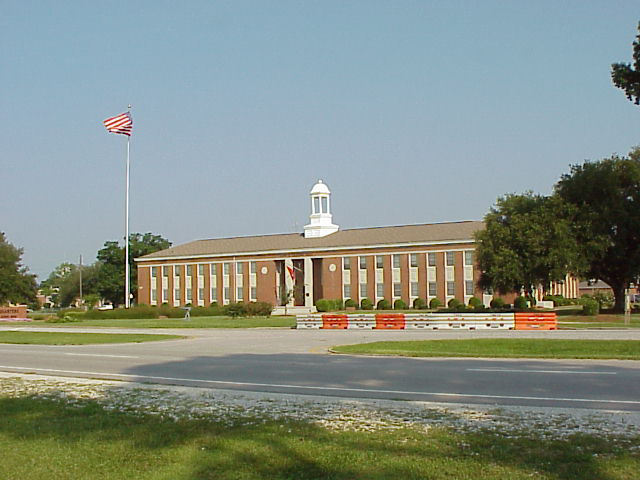
Building 1 is base headquarters. From this office, the base commanding general oversees the daily workings of a “city” of approximately 50,000 Marines, Navy personnel, civilian employees, and military families. He also provides support for an additional 90,000 military family members and retirees residing in the surrounding community.
Main Protestant Chapel
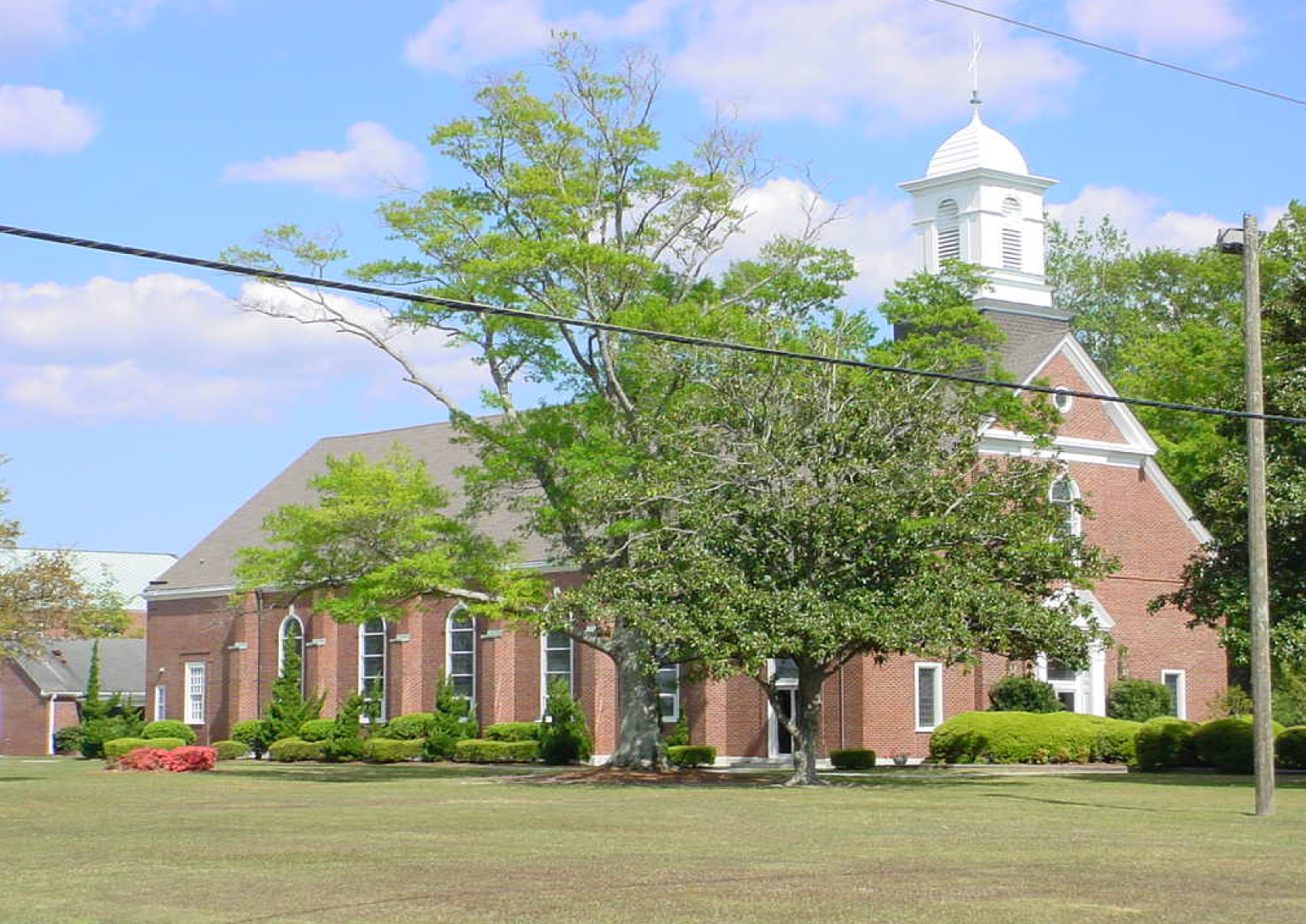
Camp Lejeune’s Main Protestant Chapel was initially dedicated on December 13, 1942, and rededicated in January 1943. The history of the U.S. Marine Corps from its founding in 1775 to World War II is movingly portrayed in ten stained glass windows designed by artist Katherine Lamb Tait and installed in 1948. Made of colored glass from the U.S., England, France, and Germany, the windows depict Old Testament archangels above illustrations of major events in Marine Corps history. In the boarders of each window are scenes from wartime photographs taken by some of the actual Marines for whom the windows were conceived as memorials. Because both Protestant and Jewish personnel use the chapel, the Star of David, and the Star of Bethlehem can be found in each window. The activity building behind the main chapel serves the local Islamic community as a center for Friday afternoon prayer services.
St. Francis Xavier Catholic Chapel

Camp Lejeune’s Roman Catholic Chapel was first dedicated as St. Aloysius on December 6, 1942, in memory of Father Aloysius Schmitt, the first base chaplain and first Catholic chaplain to die in World War II. It was rededicated at St. Francis Xavier Chapel on January 27, 1943. Each of the ten stained glass windows was designed by New Jersey artist Katherine Lamb Tait and depicts two life-size images of saints of Catholic tradition. The windows were funded as memorials to their wartime dead by the six World War II Marine Divisions, the 3rd and 5th Amphibious Corps, Fleet Marine Force Pacific, Navy personnel, and personnel of Camp Lejeune.
Camp Geiger

Marines of the 1st Division who were posted at Camp Lejeune during 1941-42 would not recognize today’s Camp Geiger as the crowded tent camp they occupied before shipping out to World War II’s Pacific theater. The first tent camp consisted mostly of six-man canvas tents, 20 feet square, arranged in blocks on a grid like street pattern. A second adjacent tent camp provided no better accommodations, offering fourteen-men “huts” made of sheets of compressed cellulose called Homosote. By the end of the war, corrugated steel Quonset huts replaced most of the tents, but the battered Homosote huts remained until the early 1950s when all the huts were removed. With new concrete block barracks, the tent camp was rededicated in 1953 and renamed in honor of Gen. Geiger. Since the 1970s, Camp Geiger has been undergoing still another rebuilding to meet the modern-day needs of the Corps’ School of Infantry, which trains more than 18,000 Marines every year.
Camp Geiger Monument Circle

Within Monument Circle are four monuments. One honors Lance Cpl. Julius C. Foster (1938-1968). Foster, a member of Company E, 2d Battalion, 26th Marines, 3d Marine Division, was killed on February 22, 1968, by hostile mortar fire during the battle for Khe Sanh, Quang Tri Province, Republic of Vietnam. A second monument, installed by the Military Order of the Devil Dogs Fun and Honor Society of the Marine Corps League, honors Marines who died in Lebanon during 1982-84. A third memorializes the service of the 4th Marine Division, which fought on Roi-Namur, Saipan, Tinian, and Iwo Jima prior to its deactivation in November 1945. The fourth monument was erected in honor of Gen. Roy Stanley Geiger (1885-1947), a pioneering Marine aviator and the namesake of Camp Geiger. Geiger commanded the 1st and 3rd Marine Amphibious Corps, and the 10th Army briefly during World War II.
Camp Geiger Chapel

United Services Organization (USO)

The United Services Organization was formed in 1941 as a joint effort of the Salvation Army, YMCA, YWCA, National Catholic Community Services, National Travelers Aid Association, and National Jewish Welfare Board to help in providing off-duty recreational opportunities for the U.S. Armed Forces. During World War II, the USO offered opportunities for community participation with 3,000 centers established as “homes away from home” for U.S. Marines, Soldiers, Sailors, and Airmen. This Jacksonville USO center was formally dedicated on April 19, 1942. A separate USO center for African American Marines operated during World War II. Members of the Women’s Reserve, and also female civilian workers at Camp Lejeune, enjoyed a special USO annex established for them. The Jacksonville USO is the oldest continuously active USO in the world. It has become famous as a training ground for hundreds of USO workers who have subsequently gone on to staff USOs on behalf of American servicemen and servicewomen around the globe.
Bicentennial Oak Tree

The Live Oak is one of the most majestic trees to be found in the coastal regions of the South. This tree is estimated to be more than 350 years old and is believed to be the oldest tree on the base. Wire cables have been added to help the tree support the massive weight of its individual limbs.
2nd Force Service Support Group Headquarters (Building 2)

During World War II, Building 2 was commanding headquarters for the Training Center, Camp Lejeune. The center’s mission was to train combat replacements and the many occupational specialists that accompanied or supported combat troops. Most of the schools, including communications, quartermaster, motor transport, signal, cooks and bakers, and field medical, took up residence in the five regimental areas that face Building 2. Building 2 has served as headquarters for 2d FSSG, which provides most of the sources of heavy combat service support for the 2d Marine Division, 2d Marine Aircraft Wing and the command element of II MEF.
2nd Tank Battalion Headquarters Building 407

Building 407 is a former barracks that, like most of the World War II-era barracks buildings at Camp Lejeune, has been converted for administration and training uses.
The M-48 tank dedicated to Medal of Honor recipient Sgt. Grant T. Timmerman and the M-60 tank are displayed on the front lawn, flanking a sign advertising the “Masters of the Iron Horse” (members of the 2d Tank Battalion) who now occupy the building.
Observation Point 5 (Poggemeyer’s Point)

This fine “Marine-made” hill is named in honor of Maj. Gen. Herman Poggemeyer, who commanded Camp Lejeune from July 18, 1975, to June 30, 1977. From the vantage point atop the OP5 tower, instructors and other official observers have an unobstructed view over the vast impact area to the east. Marine units deploy along the earth embankment for practice in the use of automatic weapons, grenade launchers, and .50-caliber machine guns.
Historic Tar Kilns
Naval stores, such as turpentine, tar, and derivatives like resin and pitch, were among the leading exports of North Carolina’s New River region in the 18th and 19th centuries. The source of these substances was the longleaf pine, which grew in great numbers on the higher elevations of this lowland area. Tar, a viscous fluid used for preserving ropes and timber, was made by slow-burning the trunks and branches of longleaf pines in “kilns” or pits roughly excavated in the forest floor. The people who worked at kilns like this were, thus, North Carolina’s first “Tar Heels.”
World War II Dry Net Amphibious Training Site
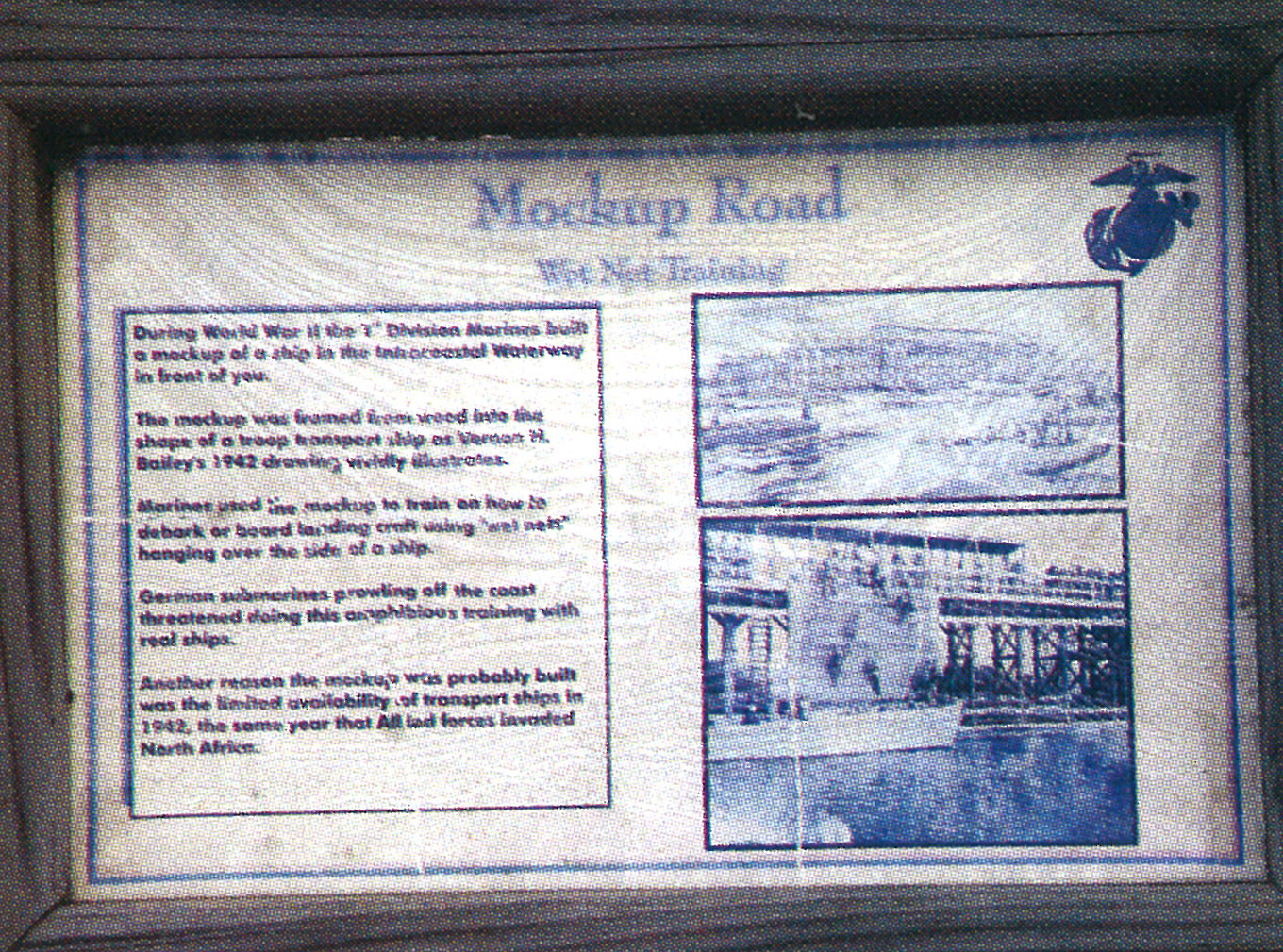
During World War II, Marines conducted amphibious landing operations using open-topped landing craft. Due to the threat from patrolling German submarines, Marines training at Camp Lejeune could not practice these operations in the sea off Onslow Beach. Instead, a full-scale mockup of a troop transport was built on the inland side of the Intracoastal Waterway, at the end of Mockup Road. With this $175,000 “movie set,” Marines learned to clamber up and down on the double while carrying a full pack and rifle.
The U.S. Army Corps of Engineers began development of the Intracoastal Waterway prior to World War I. Sheltered from the rough waters of the Atlantic Ocean by barrier islands, this inland waterway formed a reliable and safe route for coastal shipping. During World War II, Camp Lejeune operated a signals school on Onslow Beach. The beach also provides an excellent area for amphibious operations training as well as recreation for service members and their families. Training activities are scheduled with care to ensure that native Loggerhead and Green sea turtles are protected during their nesting periods on the beach.
Courthouse Bay and Harvey’s Point Park

One of Camp Lejeune’s outlying “suburbs,” Courthouse Bay is currently home of the Marine Corps Engineer School and the 2d Assault Amphibious Battalion. The complex was originally used during World War II; however, as a Barrage Balloon school (a history “memorialized” in the continued use of the letters “BB” preceding the numerical designation of buildings here). Because it was far from the main area at Hadnot Point, Courthouse Bay was built as a semi-independent village with its own water supply, recreation facilities, mess hall, barracks, and officers’ quarters. The Engineer School, which during the war had been in the 4th Regimental Area at Hadnot Point, moved to Courthouse Bay in 1945. Here, officers and enlisted personnel are given instruction and hands-on experience in a variety of engineer fields to prepare them for service with the Fleet Marine Force.
Amphibious Base Equipment Display
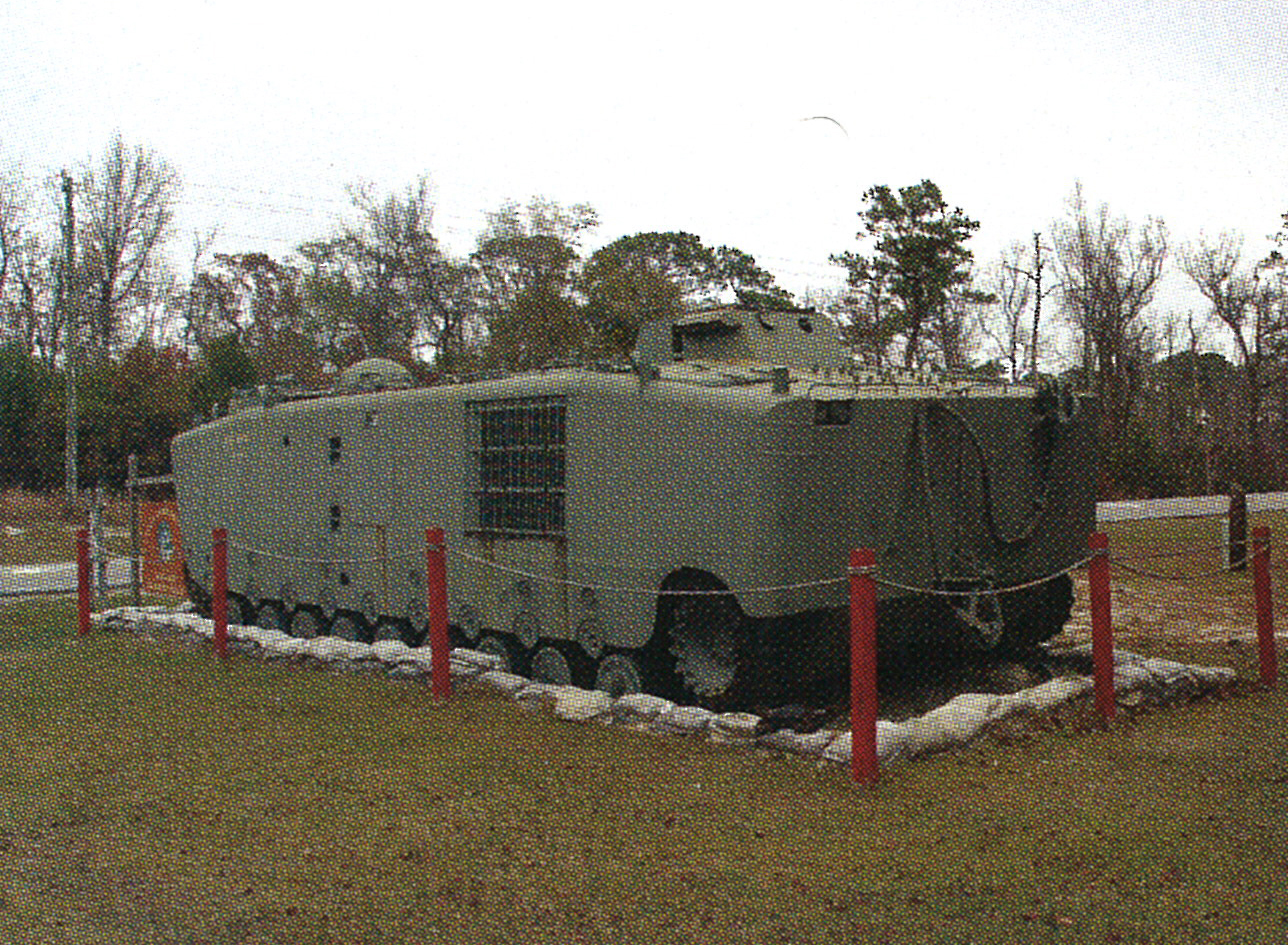
During World War II, the Amphibious Base supported an amphibious tractor detachment, a Coast Guard detachment, and a “boat detachment” that provided support for amphibious training exercises at Camp Lejeune. The vehicle displayed here is an LVTP-5A1.
Enemy Equipment Display
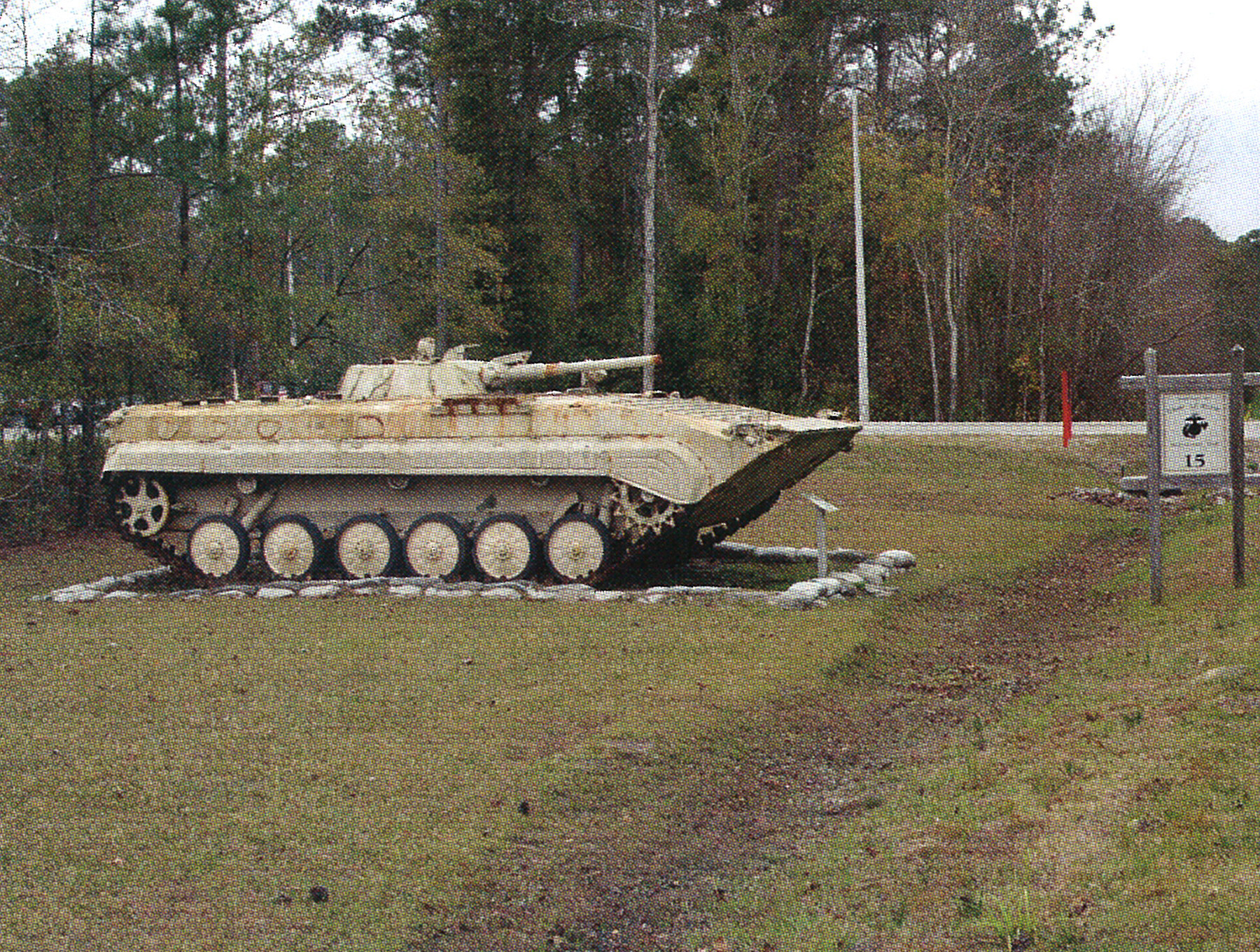
The vehicle displayed here is a “BMP” (from the Russian “Boyevaga Mashine Piechoty,” or armored personnel carrier) captured from Iraqi forces by Marines during Operation Desert Shield/Desert Storm in 1991. This particular vehicle is a Russian-built BMP-76PB, an armored amphibious personnel carrier, which conspicuously shares many of the components and design features of the Russian PT-76 light tank. Weighing 12.5 tons combat-loaded, the vehicle carries eight troops plus a crew of three. Its armament consists of a 76.2 mm gun, a 7.62 mm machine gun, and the “Sagger” anti-tank guided missile.
Yopp’s Meeting House

Yopp’s Primitive Baptist Church, the oldest organized church in the nearby village of Sneads Ferry (located off base), derives its name from Jeremiah W. Yopp, who donated an acre of land to the church trustees in 1813. Also known as Yopp’s Meeting House, the first structure on this site was built in 1835 by the Primitive Baptists and replaced by the current structure around the close of the nineteenth century. The church has a dual symmetry, easily seen in its two entrances, which reflects the early custom of segregating the congregation by gender. The adjoining cemetery contains representatives from many of Sneads Ferry’s earliest families, including several Civil War veterans.
Stone Bay Rifle Range

Thousands of Marines have achieved and maintained proficiency with pistols and rifles at this little “base within the base,” which looks pretty much the way it did when Marines first came to practice here in World War II. Stone Bay is equipped with its own water supply, fire station, heating plant, recreation facilities, mess hall, and barracks to berth a full battalion, all in brick buildings identical to their counterparts at Hadnot Point and Courthouse Bay. Along the north side of the complex are two pistol ranges, three 50-target rifle ranges, and a 1,000-yard sniper range, supported by range houses, target huts, and magazines. On the rifle range, the little red wooden huts called “control towers’ are mounted on wheels so that during rifle re-qualification they can be moved back as the shooters fire from the 200 to the 300 to the 500 yard lines. Red flags are hoisted when a range is in use, or “hot.”
MCAS New River Heroes’ Park
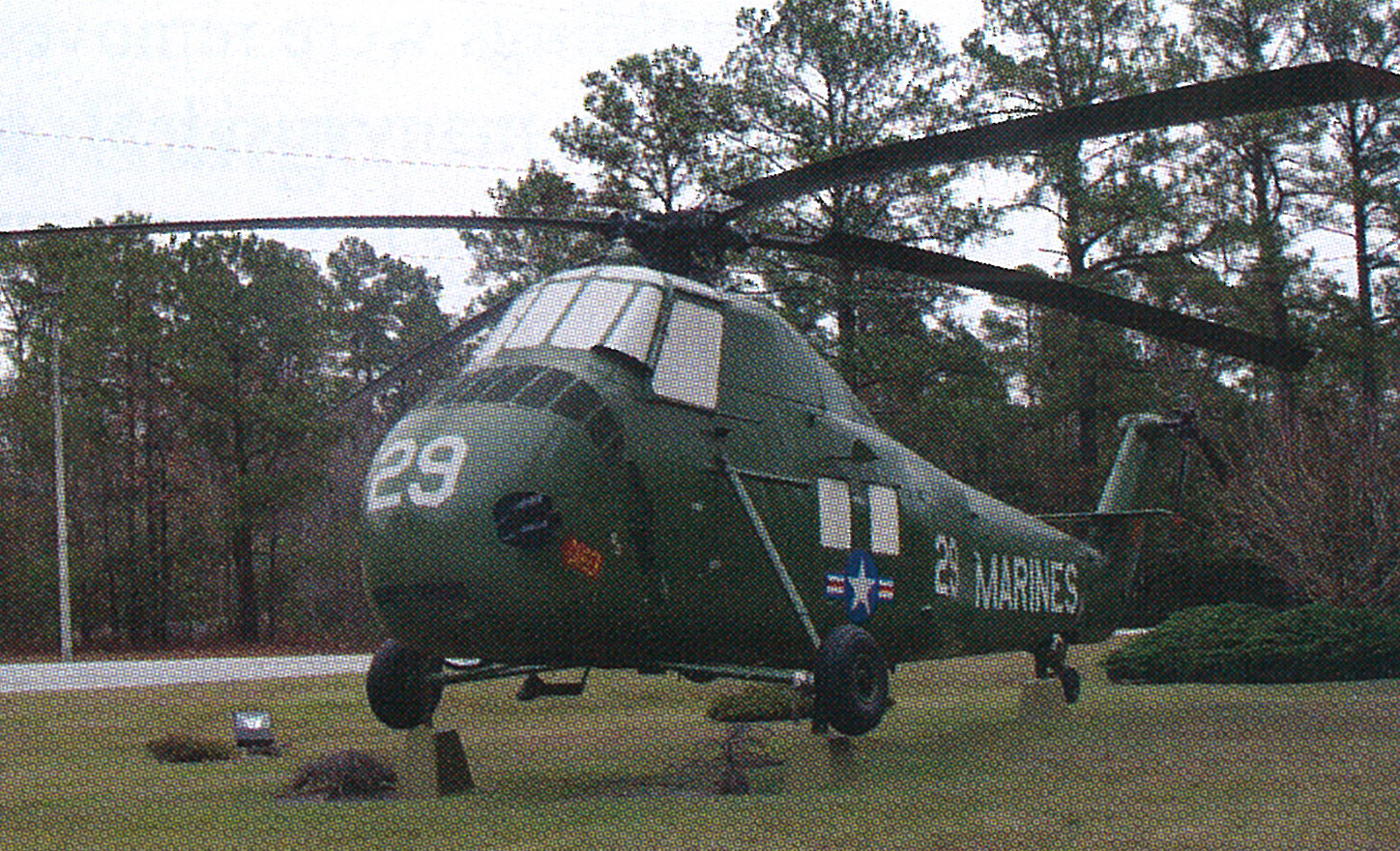
Heroes’ Park commemorates Marines, particularly those of air units, who have died in locations and events other than those commemorated at other sites such as the Catholic Chapel, the Montford Point Chapel, and the Main Protestant Chapel. On this site, which in the future will contain the New River Aviation Memorial Park, are two helicopters, a CH-34 and a CH-53, flanking a formal grouping of three flags.
During World War II, what is now MCAS New River was known variously as “Emergency Landing Field,” “Glider Training Base,” “Seaplane Base,” or simply “the airfield at Peterfield Point.” By October 1942, the airfield consisted of mainly three, 5,000-foot runways, a seaplane ramp, and glider repair shops. In June 1943, the Marine Corps terminated its glider program since gliders were of no use in the war in the Pacific. The airfield was used briefly by airplanes carrying parachute troops on practice jumps and for most of the rest of the war as a training facility. Since the arrival of Marine Air Group 26 in 1954, when helicopters were first deployed here, MCAS New River has grown substantially. On June 8, 1972, the station was named McCutcheon Field in honor of Gen. Keith B. McCutcheon (1916-1971), considered to be the father of Marine Corps helicopter aviation and also the Corps’ first four-star aviator.
Beirut Memorial

Dedicated in 1986, this graceful monument pays homage to the 273 Marines, Soldiers, and Sailors who died in the service to their nation in Beirut, Lebanon, and during the Grenada invasion. Names of the deceased are engraved on gray granite walls set in a placed grove of Carolina pines and azaleas. A bronze statue of a Marine stands in an eternal vigil over his comrades, facing the N.C. Veterans’ Cemetery Chapel. Funded entirely by donations of private citizens and businesses, the memorial has become one of the most important destinations for visitors to Onslow County and Camp Lejeune.
Complimenting the memorial are 273 Bradford pear trees, one for each service member honored, planted along Lejeune Boulevard (NC 24) from the memorial to the main gate of Camp Lejeune. A joint Marine and civilian Beirut Memorial Advisory Board that sponsors an annual memorial service every October 23rd maintains the memorial.
Snead’s Ferry

Onslow County’s first ferry over the New River was established here in 1728 by Edmund Ennett as part of the Colonial Post Road or “King’s Road” that ran between Boston and Charleston, SC. It acquired its current name when purchased by Robert Snead in 1759 and was replaced by the first bridge over the narrows here in 1939.
Federal Gunboat “Ellis”

During the Civil War the US gunboat “Ellis,” commanded by Lt. William B. Cushing, raided up the New River on November 23, 1863, briefly occupying Jacksonville, capturing two merchant vessels and destroying another. While withdrawing, the “Ellis” ran aground off Swan’s Point (three miles southeast) and was destroyed on November 25 by Co. G, 3rd NC Artillery. Cushing escaped to sea with his crew aboard the captured merchant vessels.
Pest House

The Revolutionary War introduced the first of a series of smallpox epidemics that would rage through Onslow County during the 18th and 19th centuries. A pest house was established by court order in January 1782 near here as a place to be inoculated to control the contagion.
Onslow Hall

Built in 1892 by Thomas A. McIntyre, New York financier and builder of the Jacksonville-Wilmington railroad. This 27 room mansion stood on the “Glenoe,” a 2600 acre plantation that included trotting stables and a model stock farm. The estate, located four miles southeast of here, was later known as “Coddington” following its purchase in 1919 by Charles C. Coddington and was a show place for three decades.
Town Point

Originally known as Mittam’s Point, Town Point, located five miles southeast of here, was the site of Johnston, in 1741 Onslow County’s first incorporated town and third county seat. After its destruction by a hurricane in 1752, the town was abandoned and the county seat was moved in 1757 to Wantland’s Ferry in Present-day Jacksonville.
Town of Marines
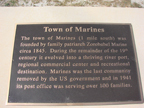
The town of Marines (1 mile south) was founded by family patriarch Zorobabel Marine circa 1845. During the remainder of the 19th century it evolved into a thriving river port, regional commercial center and recreational destination. Marines was the last community removed by the US government and in 1941 its post office was serving over 100 families.
First Settlement

The first settlers that moved into the area that became Camp Lejeune are believed to be the three Dexter brothers from Massachusetts. Phillip and Ebenezer settled on Bear Creek, near Bear Inlet, as early as 1713, followed in 1726 by Hope Dexter on Mittam’s, later known as Town Point, in 1741 the site of Johnston, Onslow County’s first town. Settlement did not begin until the conclusion of the Tuscarora War, the last major uprising by Native Americans in eastern North Carolina.
Colonel Edward Ward, Sr. Plantation

In 1735, Col. Edward Ward, Sr., (born 1694, died 1766) a veteran of the Tuscarora Indian War, established a plantation here on a 200-acre tract and attained considerable wealth and prominence in the naval stores industry. His grave and that of his wife Elizabeth were moved to the Montford Point Cemetery in 1941 and are the oldest graves located there.
Hurst Beach
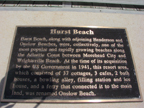
Hurst Beach, along with adjoining Henderson and Onslow Beaches, were, collectively, one of the most popular and rapidly growing beaches along the Atlantic Coast between Morehead City and Wrightsville Beach. At the time of its acquisition by the US Government in 1941, this resort area, which consisted of 37 cottages, 3 cafes, 2 bath houses, a bowling alley, filling station and ice house, and a ferry that connected it to the main land, was renamed Onslow Beach.
Mitchell-Ward-Montford Mill

In 1779, Colonel George Mitchell, leader of the Onslow County militia during the last few years of the American Revolution, constructed one of the most notable of numerous water‐powered mills in the Camp Lejeune area on Wallace Creek in this vicinity. This grist mill was subsequently owned by two other prominent Onslow County citizens, General Edward Ward and Dr. William J. Montfort, Sr., and operated into the early 20th century.
Building A1

Building A1 / Carpenter Shop. The Assault Amphibian Base at MCB Camp Lejeune was built in 1942, and provided enlisted personnel with training in amphibious landings. Between the First and Second World War, amphibious landing capabilities emerged as a primary mission for the Marine Corps, as they provided the tactical basis for the primary wartime missions of seizing, occupying, and defending advance bases for naval operations. The district was thus determined eligible for listing on the National Register under Criterion A – its direct association with the primary mission of MCB Camp Lejeune during World War II. The district contains two contributing resources: Buildings A‐1 (Carpenter Shop) and A‐2 (Machine Shop).
Building 1700 / Main Power Plant

Located within the Hadnot Point Area of the Command Services / Regimental Area No. 3 Historic District.
PT6

As part of the Marines’ planned use of paratroop landings in offensive support of amphibious assaults, parachute training facilities were established at Camp Lejeune and at Camp Gillespie near San Diego, California, in mid-1942. Camp Lejeune’s facilities included three steel training towers with associated equipment buildings (PT-4, PT-5, PT-6), a parachute storage and packing building (PT-1), a training building with airplane fuselage mock-ups (PT-2), jumping platforms, and a small heating plant (PT-3). After training four battalions of paratroop Marines at Camp Lejeune, the Marine Corps consolidated the Lejeune and Gillespie programs into one program stationed at Camp Gillespie in July 1943. The Marines discontinued their parachute training program altogether prior to the war’s end because of its ineffectiveness as a weapon in the islands in the Pacific theater. Although somewhat short-lived, the Camp Lejeune parachute program served an important role in Camp Lejeune’s overall mission of training and preparing personnel for combat roles.
Building M100

Administration Building (original use), Montford Point Marine Association Historical Reading Room (current use).
Building M101

Montford Point Mess Hall (original use), Montford Point Classroom (current use).
Building TC-601

Today the Chapel (TC601), built between late 1941 and 1942, is the only building remaining from the World War II era Tent Camps 1 and 2. It stands at what was originally the center of this encampment.
Building M-116 / Montford Point Chapel

Montford Point Chapel